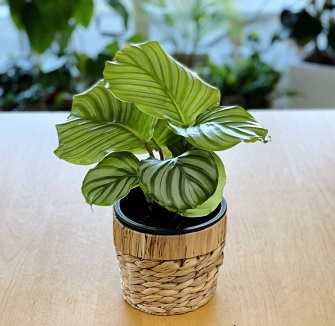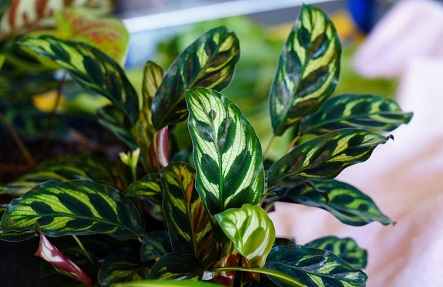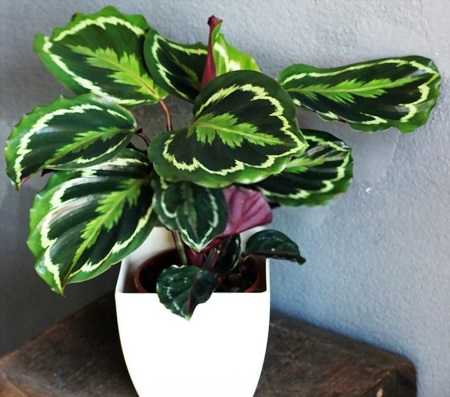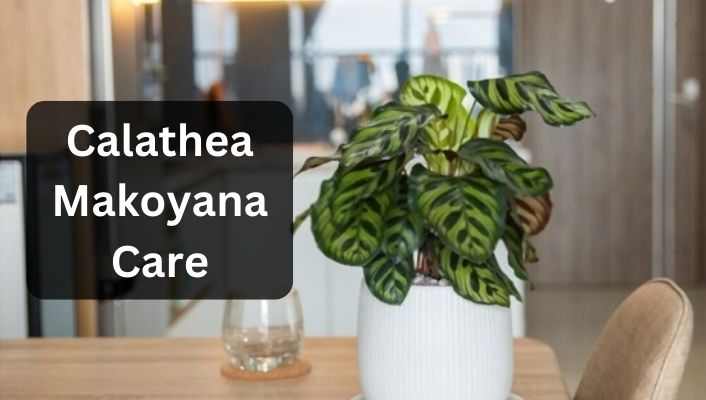Calathea Makoyana is mostly known as the Peacock Plant or Cathedral Windows. It is of Brazilian tropical origins, and the Peacock Plant is a tall (almost 2ft), slender plant that, switching the right care, can become a colorful house plant for your collection.
So read on to learn more about Calathea Makoyana care!
Post Contents
- Characteristics of Calathea Makoyana
- Size and Growth
- Calathea Makoyana Care and Maintenance
- Calathea Makoyana Light Requirements
- Watering the Peacock Calathea
- Temperature Boundaries of Peacock Plant
- Humidity Requirements of the Plant
- Best Kind of Soil
- Fertilizing
- Pruning
- Repotting and Propagation
- Frequently Asked Questions
- Conclusion
- Author
Characteristics of Calathea Makoyana
The Peacock plant has all the elegance and beauty of a Peacock’s tail, which is why it has been given its rather glorious name. The leaves are pale green with a dark green feathered effect from the middle of the leaf to the outer edges.
When new leaves grow, they are rolled up and show off their pinkish-red undersides, which gives them another alluring splash of color.
Size and Growth
Generally, the size of Peacock Calathea grows up to 2 feet in height, and it doesn’t form clusters. Rather it’s a slender and tall plant.
In the following article, you’ll find everything you need to know about caring for and maintaining Calathea makoyana, from planting and watering to fertilizing and propagating.
Related Post: Calathea Crocata Care & Growing (Eternal Flame Plant)
Calathea Makoyana Care and Maintenance
Below is a perfectly gathered guide with all the essential tips for keeping your plant happy and healthy.
Calathea Makoyana Light Requirements
Peacock plants are native to the tropical forests of Brazil, where they grow in the high shades of the forest, where there is little direct light at ground level. Because of this, they have very low light requirements than many other houseplants.
Talking about the light requirements, it is almost the same as most tropical indoor houseplants. Calathea makoyana prefers bright indirect light. This plant cannot withstand strong direct sunlight because this plant has very thin leaves, which can burn very easily.

The Calathea Makoyana takes time for proper acclimation; before that, you should provide it with a perfect environment. We recommend you place your plant against a north-facing window. This place will provide the kind of bright indirect light that a peacock plant appreciates.
Watering the Peacock Calathea
Watering is an important part of the Calathea Makoyana care. Keeping watering and humidity levels right is useful in peacock plant care. The trick with watering is just like other calathea varieties: to keep the soil nicely moist but avoid letting it get soggy.
We recommend you water the peacock plant once the top of the soil starts to feel a little dry. Take your plant to any sink and water it thoroughly until water runs freely from the drainage holes. After this, place the plant in the sink so that all the excess water drains out, leaving nicely moist but not soggy soil.
Now a quick point to keep in mind is that plant growth slows down during the winter. You have to allow the top half-inch of potting soil in the container to dry out before watering your plant again. Yellow leaves indicate over-watering, and brown leaves mean the plant needs more water.
Always choose room temperature distilled water or naturally collected rainwater. Fluoride in normal tap water can damage your fragile plant. Still, if you use tap water, let it sit for a couple of days to allow the minerals to dissipate before watering your plant.
Also Read: Cucumber Plant Stages of Growth
Temperature Boundaries of Peacock Plant
Tropical houseplants always prefer normal room temperature, just like humans do. The recommended temperature for the best growth of your peacock plants is in a room where temperatures are between 60°F-75ºF (16C°-24ºC). Always remember to avoid a sudden drop in temperatures.
Always keep your plant in a spot that is away from any winds coming from leaky windows, opening/closing doors, or vents blowing heat in the winter and cool summer air.
In cooler growing zones, we recommend taking your Peacock plant outside in the warmer times of spring and summer months, then bringing it indoors at night. But remember, when taking your plant outside, look for a shaded location or under the canopy of trees or other plants to keep it out of direct sunlight.
It’s better to keep things around room temperature, although warmer isn’t a problem for this species. They’re used to the hot sun in those Brazilian jungles.
Humidity Requirements of the Plant
Peacock plants thrive in humidity levels that are above 60%. They do well in bathrooms if they can receive enough sunlight. Because in bathrooms, the warm, moist air is very similar to their rainforest origins.
If your plant is starting to show signs of brown leaf edges or tips, this is a sign of low humidity. So, considering all of this, we conclude that humidity is very important for these plants.

Not only with Makoyana but with all calathea varieties, it is important to check humidity levels to prevent any problems.
Now talking about how to increase humidity. To do this, there are lots of options. Most people recommend misting your houseplants, but this is not a reliable way to increase humidity.
We recommend grouping your plants and placing them in a tray containing stones, pebbles and water. And if you want extra care, you can opt for an electric humidifier.
Related Article:
Best Kind of Soil
The soil is a key element in Calathea Makoyana care. You should always consider soil that can handle your plant’s love for water and dislike of getting soaked. You can easily mix your medium for this purpose.
Most “all-purpose” commercial potting soils are suitable for the Makoyana because they are formulated with those needs in mind.
But for making your own, the easiest way is mixing two parts of regular houseplant potting soil, one part sphagnum moss or coco coir, and one part perlite.
The moss/coir holds some moisture, but not too much. The perlite, on the other end, keeps things airy and allows excess water to flow away freely.
Avoid using straight coconut coir or a lot of sphagnum peat moss in your containers, as they retain too much water, which is harmful.
If you want to improve the drainage rate of the potting soil, you can add extra perlite or sand. Mix the components well in a larger bucket, and then use the mix to fill your container when potting up your plant.
Fertilizing
Fertilize your peacock plant with a balanced or high-nitrogen liquid houseplant fertilizer every 2-4 weeks from spring through to early Autumn when the plant is actively growing.
Calatheas are quite sensitive to over-fertilization. Use a liquid or water-soluble fertilizer at half the recommended strength or less.
Stop fertilizing your Peacock Calathea during the winter because the growth has slowed. Excess fertilizer can burn the root system and cause obvious leaf spots.
Pruning
Like all other houseplants, your Calathea doesn’t need much in terms of pruning. When the leaves age, they will turn yellow or brown and die. For pruning, you can trim off dead leaves with a pair of sharp, sterilized scissors, cutting them off where they join the main stem or at the soil level.
For beautification needs, you can prune your Calathea makoyana to maintain a more compact, bushy growth habit.
Trimming off the dead leaves is recommended because the more unnatural pruning will cause the plant to decline.
Repotting and Propagation
You should repot your peacock plant to a slightly larger container every 1-2 years. Do this in the springtime or early summer. These times are the best because the plants begin actively growing during springtime after the cooler winter months and can quickly handle the shock of repotting.
Always add new potting soil or mixed finished compost to “refresh” the nutrient content and organic matter. Make sure to loosen up the roots if they are root bound.

You should always propagate peacock plants through division. When it is time to repot plants, carefully divide the crown and root ball into two or more sections. Then repot each section into its new container with fresh potting soil.
Frequently Asked Questions
Is Calathea makoyana toxic to pets?
No! The Calathea Makoyana is pet-safe, making them a great option for safety-conscious people. Plus, they’re also safe for humans.
Why does Calathea makoyana have brown leaf tips?
If this happens, it may be too dry for this tropical plant to grow. You can often restore this by running a humidifier. Moreover, don’t use tap water for them as Calatheas are known to be sensitive to the minerals (like fluoride) in tap water.
Are Peacock Plants Flowering?
Yes, peacock plants flower, but it is not frequent. Tiny white flowers may sometimes be seen peeping through pale green bracks on mature plants throughout the year. Usually, they are unnoticeable.
Is caring for Calathea makoyana an easy job?
Yes! Calathea Makoyana is an easy plant to care for and grows well indoors. But the points discussed in the article are a must examine.
Should I shower my Calathea?
You can perform lukewarm showers. Use a spray attachment near a sink or put them in the shower with other plants that need high humidity.
Conclusion
And that’s all for it. The Calathea Makoyana is generally easy to care for, but once you stick to these points, we discussed them. Then you can take your plant’s growth to an extra level. This will also help Calathea to stay healthy and beautiful.
If you understand all the essentials, you’re ready to get one of these amazing plants. Keeping peacock plants beautiful can only be done by using the tricks from this article. Now I hope you will be able to grow a perfect plant with our Calathea Makoyana care guide.
Read More Related Articles:

